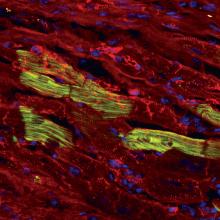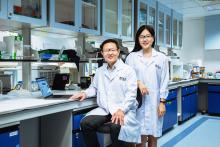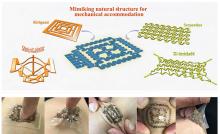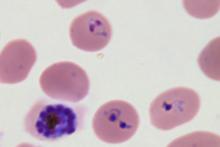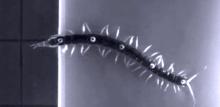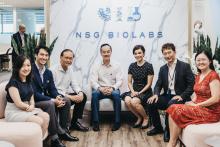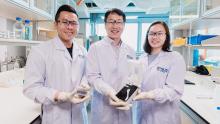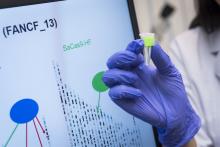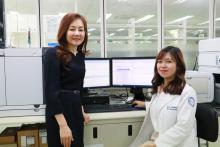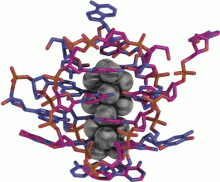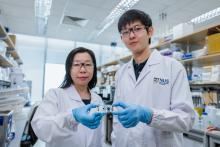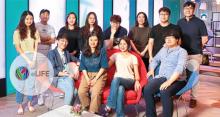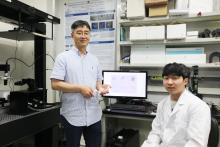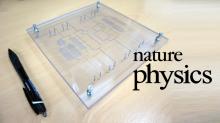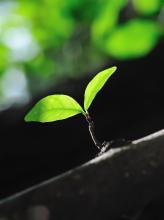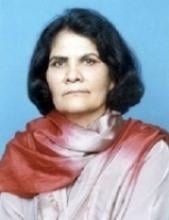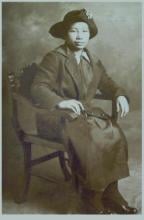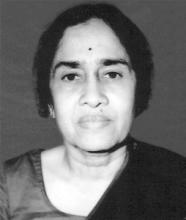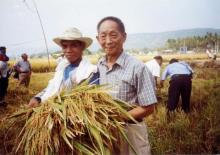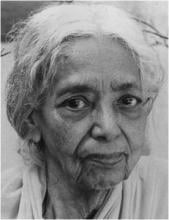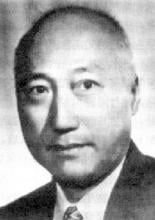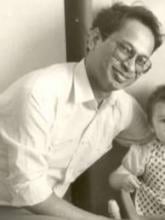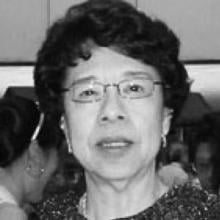Biotech
News
22 Jan 2020
Researchers have discovered a method to control biomolecular machines over a wide temperature range using deep-sea osmolyte trimethylamine N-oxide (TMAO). This finding could open a new dimension in the application of artificial machines fabricated from biomolecular motors and other proteins.
22 Jan 2020
Researchers at Tohoku University have developed a new type of smart contact lenses that can prevent dry eyes. The self-moisturising system, which is described in the journal Advanced Materials Technologies, maintains a layer of fluid between the contact lens and the eye using a novel mechanism.
21 Jan 2020
Using tissue engineering techniques, researchers are developing living heart valves that can grow after implantation in the human heart.
14 Jan 2020
A new approach uses two types of stem cells to repair both heart muscle and blood vessels damaged during severe heart attacks.
14 Jan 2020
A team of researchers from the National University of Singapore has developed a personalised assessment tool which can detect the incidence of cancer, predict patient survivability and determine patient suitability for immunotherapy cancer treatment.
07 Jan 2020
Dramatically improved sensor stability with complex structural design that mimics snake motions, spider webs, and paper craft. Expected to be applied in various fields such as bio-diagnosis, smart skin, clothes, and livestock diagnosis.
25 Dec 2019
Malaria parasites transform healthy red blood cells into rigid versions of themselves that clump together, hindering the transportation of oxygen. The infectious disease affects more than 200 million people across the world and causes nearly half a million deaths every year, according to the World Health Organization’s 2018 report on malaria. Until now, however, researchers did not have a strong understanding of how the parasite so effectively infiltrated a system’s red blood cells.
06 Dec 2019
Scientists in Korea find a protein that mediates the interaction between the cellular systems involved in rapid responses against foreign genes in plants
27 Nov 2019
Singapore’s first and largest co-working laboratory and office space is fully equipped and designed to help biotech start-ups commercialise breakthrough innovations
22 Nov 2019
Husband and wife team, Kimishige (3 December 1925 – 6 July 2018) and Teruko Ishizaka (28 September 1926 – 4 June 2019) discovered the antibody class Immunoglobulin E (IgE) that triggers allergic reactions.
11 Nov 2019
Dr. Jinung An explores the human brain to discover the origin of ‘human hand motor skill.’
06 Nov 2019
A team of engineers from the National University of Singapore has developed a highly sensitive system that uses a smartphone to rapidly detect the presence of toxin-producing algae in water within 15 minutes. This technological breakthrough could play a big role in preventing the spread of harmful microorganisms in aquatic environments, which could threaten global public health and cause environmental problems.
01 Nov 2019
A team of researchers from City University of Hong Kong (CityU) and Karolinska Institutet has recently developed a new protein which can help increase the targeting accuracy in the genome editing process. It is believed that it would be useful for future gene therapies in human which require high precision.
30 Oct 2019
Development of novel agonist antibodies to treat cancer by collaboration between academia and industry
19 Sep 2019
Professor Eun-Kyoung Kim’s team in the Department of Brain and Cognitive Sciences discovered the mechanism underlying the regulation of energy metabolism by hypothalamic tanycyte. Proposed a new research direction to develop an enhanced obesity treatment.
11 Sep 2019
Determination of the crystal structure of a DNA-stabilized silver nanocluster
10 Sep 2019
STAMP technology is a million times more sensitive and comprehensive to accurately detect and classify tumours from a small clinical sample
06 Sep 2019
A recent study, affiliated with South Korea's Ulsan National Institute of Science and Technology (UNIST) has identified the sleep-promoting effects of dietary threonine, as well as its neurobiological principle.
03 Sep 2019
DGIST Professor Hongsoo Choi’s team developed a biodegradable micro-robot that performs both drug release and hyperthermia treatment into a desired area. Improved drug treatment and opened a new path of future anti-cancer treatment.
03 Sep 2019
DGIST Professor Sanghoon Lee’s team developed a novel neuromodulation interface that converts friction energy into for electrical neurostimulation energy to treat underactive bladder. Expected to be widely applied for the treatment of neurological disorders.
31 Aug 2019
Advanced Materials publishes a special issue, highlighting some of the outstanding works of South Korea's Ulsan National Institute of Science and Technology (UNIST).
29 Aug 2019
Successfully identified the existence of two types of 'gastric isthmus stem cells' with different roles and characteristics using a multi-color identification technology. Expects to clarify and treat causes of gastric diseases such as cancer.
27 Aug 2019
A recent study, affiliated with South Korea's Ulsan National Institute of Science and Technology (UNIST) has successfully modeled network channels similar to our blood capillaries in the simplest way containing one or two loops.
19 Aug 2019
A new high-resolution approach using portable DNA sequencers provides a more complete genomic picture of antibiotic resistance in gut bacteria.
13 Aug 2019
UK Research and Innovation and its partners are funding 13 research programs, building collaborations across 10 countries, including Japan, China, Singapore and India.
09 Aug 2019
Chronic stress induces autophagic death of adult hippocampal neural stem cells (NSCs). Expected to offer new opportunities for development of early treatment options for stress-associated brain diseases.

11 Jun 2019
It’s Asia’s biggest biotech industry event of the year! Early bird discount ends June 22nd.
24 Jan 2019
Scientists have successfully constructed a three-dimensional human epidermis based on predictions made by their mathematical model of epidermal homeostasis, providing a new tool for basic research and drug development.
21 Jan 2019
Flowering plant parents cooperate to guide proper development of offspring; insight that could lead to new hybrid plants.
Events
Sorry, no events coming up for this topic.
Researchers
Sorry, no researchers coming up for this topic.
Giants in history
Pakistani botanist Azra Quraishi (22 September 1945 – 22 November 2002) is recognised for developing virus-free seed potatoes that increased potato production in Pakistan by an estimated five per cent.
Indian botanist Shipra Guha-Mukherjee (13 July 1938 – 15 September 2007) made a breakthrough discovery that enabled the genetic study of plants and, by extension, the development of improved varieties of rice, wheat, potatoes, and other crops.
Japanese chemist Takamine Jokichi (3 November 1854 – 22 July 1922) founded the Tokyo Artificial Fertilizer Company, where he isolated a starch-digesting enzyme (named takadiastase) from the fungus Aspergillus oryzae.
Filipina chemist María Orosa (29 November 1892–13 February 1945) fought malnutrition and food insecurity in the Philippines by devising over 700 culinary creations including Soyalac, a nutrient rich drink made from soybeans, and Darak, rice cookies packed with Vitamin B1, which could prevent beriberi disease caused by Vitamin B1 deficiency. She was also a partisan of the guerrilla movement resisting Japanese occupation during World War II, and died after being struck by shrapnel while working in her laboratory during the Battle of Manila.
Chinese biochemist Cao Tianqin (5 December 1920 – 8 January 1995) discovered the myosin light chain, a subunit of myosin, a protein crucial for muscle contraction.
In 1939, biochemist Kamala Sohonie (18 June 1911 – 28 June 1998) became the first woman to be accepted into the Indian Institute of Science (IISc).
Chinese agronomist Yuan Longping (7 September 1930 – 22 May 2021) developed the first varieties of the high-yield, hybrid rice that brought food security to multiple countries including China, which had been ravaged by food shortages as recently as the mid-20th century.
David T. Wong (born 1936) is a Hong Kong-born American neuroscientist who is best known for discovering the antidepressant drug fluoxetine, better known as Prozac.
Cyril Andrew Ponnamperuma (16 October 1923 – 20 December 1994) was a Sri Lankan chemist who was interested in the origins of life on Earth. His research in chemical evolution showed how inanimate molecules may have given rise to the building blocks of life – a process known as abiogenesis.
Osamu Shimomura (27 August 1928 – 19 October 2018) was a Japanese organic chemist and marine biologist who dedicated his career to understanding how organisms emitted light.
Janaki Ammal Edavalath Kakkat (4 November 1897 – 7 February 1984) was an Indian botanist who studied plant chromosomes and genetics.
Gopalasamudram Narayanan Ramachandran (8 October 1922 – 7 April 2001) is best known for developing the Ramachandran plot to understand the structure of short chains of amino acids, known as peptides.
Hsien Wu (24 November 1893 – 8 August 1959) is widely regarded as the founder of biochemistry and nutrition science in China. He was the first to propose that protein denaturation was caused by the unfolding of the protein, instead of chemical alteration.
Umetaro Suzuki (7 April 1874 – 20 September 1943) was a Japanese scientist best remembered for his research on beriberi, a disease caused by vitamin B1 deficiency, characterized by limb stiffness, paralysis and pain.
Maqsudul Alam (14 December 1954 – 20 December 2014) was a biologist from Bangladesh who is renowned for his research on genome sequencing
Barry Paw (29 August 1962 – 28 December 2017) was a biologist and oncologist who discovered several novel genes and their functions in red blood cells.
Gloria Lim (1930-2022) was a mycologist from Singapore who studied tropical fungi. One of the first students to attend University of Malaya when it was founded in 1949, she went on to become the first female Dean of the Faculty of Science at the University of Singapore.





